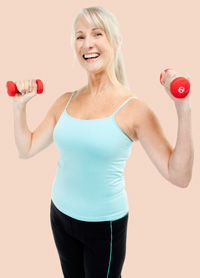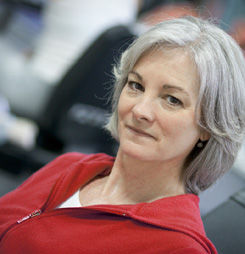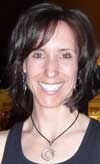
BY KAREN ASP
True (and obvious) statement: No matter when you started your career in the fitness industry, you were younger than you are now. Yet for many of you, you’re crossing the line where that once youthful body is morphing into a more mature physique, complete with all of the aches and pains—both physical and emotional—that age often brings.
Are you planning on continuing to work in the fitness industry as you grow older? What do you think your biggest challenge will be?
An aging body can often be tough to accept, especially in a society that places a high value on looking and staying young. The fitness industry is no exception, which begs this question: How can you maintain longevity as a fitness professional as you face the woes of aging? To answer that question, we turned to veterans of the fitness industry who reveal their secrets for maintaining a thriving, successful career. What they have to say may convince you that age truly is just a number.
Why Mature Fitness Pros Have the Upper Hand
With all of the anti-aging lotions on the market, birthday cards that poke fun at blowing out yet another candle and spa treatments designed to defy aging, you might assume that being older poses a disadvantage for fitness professionals. Surprisingly, for many the opposite is true. “Because of my life experiences, I can relate so much better to what my students are going through than when I first started teaching 20 years ago,” says Chris Freytag, 46, member of the ACE Board of Directors, Minnesota-based personal trainer and group fitness instructor and creator of numerous fitness DVDs.
For Joy Prouty, age plays to her advantage as well. “Age is an asset,” says Prouty, director of training for Zumba and co-developer of Zumba Gold, owner of Fitness Programming in West Palm Beach, Fla., and an international fitness instructor and program developer who taught her first fitness class in 1965. She just turned 70 and is still going strong. “In recent years, I’ve assumed more of a role as educator and mentor in this business, which is exactly where I want to be because I believe that with the experience and knowledge I’ve gained over the years, I have so much to offer younger fitness professionals.”
Another advantage? These more mature fitness professionals have an emotional intelligence that younger fitness professionals may not yet possess.
“Because you’re experiencing your own discomfort in your body, you appreciate your own good health more than you did when you were younger and, as a result, you become more empathetic toward others,” says Ken Alan, 57, lecturer at California State University in Fullerton, Calif., who began teaching in 1976 and has been a leading conference presenter, choreographer, program designer and member of numerous ACE committees.
Compassion might be another facet of that emotional intelligence, which is what Keli Roberts, California-based personal trainer, international fitness presenter and star of numerous fitness videos, says she’s gained from being in the fitness industry since 1986. “When I first started teaching, the only level I knew was hard, and if you didn’t keep up, even if you were a beginner, I would yell at you,” says Roberts, 50. But not anymore. “I know so much more about the body now than I did then, and that’s helped me soften my ways and become a better instructor.”
That experience is something that appeals to older adults, especially those who are seeking help from fitness professionals who understand their woes. Take, for instance, 65-year-old Josie Gardiner, who is a Zumba education specialist, co-author (with Prouty) of Core! (Harvard Medical School, 2011), 2002 IDEA Instructor of the Year and 2005 ACE Group Fitness Instructor of the Year, and teaches and trains clients in Boston. “One of my more mature clients recently said she loves working with me because I’m not going to make her do something that doesn’t feel good,” Gardiner says. However, if that same client were to go to a younger trainer, the story might be different. “Because younger trainers don’t have the same experience and don’t understand the aging body, they sometimes push clients too hard and too fast, which often results in clients getting injured and not wanting to exercise anymore.”
That emotional maturity yields another advantage: “Teaching and training become so much more about your students and not about you,” Prouty says. Your participants often sense that, which is what has helped professionals like Prouty build a loyal following.
There may also be another reason clients are drawn to older fitness pros: Simply put, they offer unique inspiration. “It’s easy to look great when you’re 25,” says Sheila Cluff, 76, founder of the destination spa resort Oaks at Ojai in Ojai, Calif., and internationally known fitness expert who began teaching fitness in her 20s. “Yet when students see how I look and what I can do at my age, they say I want to be just like you. The more of an example I can be at my age, the more it motivates students, especially younger ones.”
Transitioning Into Your Aging Body
Letting go of your old (younger?) self is perhaps one of the most challenging parts of aging. Maybe you’re not able to exercise as long or as hard as you used to. Maybe you feel more twinges in your body. Or maybe you just look and feel, well, older. This evolution is something everyone will undergo, but for fitness professionals who are so attached to their body’s performance, it can often be a difficult transition—unless, that is, you learn how to move forward.

This change begins with what Vivian Diller, Ph.D., psychologist in New York City and author of Face It (Hay House, 2011), calls an “aha moment.” “You have that gut feeling or maybe even a physical clue that your body’s changing, and you know there’s no turning back,” she says.
These changes usually trigger a certain sadness, and that’s completely normal. “Psychological mourning, which includes sadness, almost always follows loss, no matter what that loss is,” Diller says. Yet in the long run, that sadness will work to your advantage. “Until you go through that mourning process, you can’t let go of that older self,” she says, adding that it’s often easy to spot individuals who are having trouble letting go. They’re the ones who continue to push their bodies and don’t give their bodies room to be different.
Alan, for instance, admits that he had trouble dealing with his aging body. “It took me a while to accept my fitness level,” he says, adding that there are workouts he’s done for 20 years that are harder to do now than they were 20 years ago. “I have the same spirit but a different body, and I’ve had to accept this change.”
As Alan learned, once you do let go, you can begin to work on a different goal: Being the best you can be at your current age. To get to that point, follow these strategies:
- Don’t let fitness define you. For years, you’ve probably been used to having physical activity be the main part of your identity. Yet although fitness can be a large part of your identity, it shouldn’t be the only thing that defines you. “Connect your identity to other aspects of yourself that are less dependent on physicality and youth,” Diller says.
- Shift your definition of fitness. When Diller works with professional athletes who are forced to retire, she constantly reminds them that they have to become more flexible in how they measure their fitness. “You have to be able to see yourself as being fit without using the same standards to measure your fitness as when you were in your 20s and 30s,” Diller says. For instance, maybe you can’t do as many push-ups at 60 years old as you did at 40 years old or maybe you can’t run a mile as fast as you did a decade ago, and that’s okay. “If you want to learn to love your new body, your perception of being fit has to change,” she adds.
- Home in on your non-physical strengths. Remember that you bring to the table much more than your physical assets. “You bring wisdom and experience to your clients that younger fitness professionals can’t offer,” Diller says. Perhaps even more importantly, you serve as a living example of how a fit lifestyle can benefit people, and this is perhaps the greatest gift you can give clients. “If you can teach the millions of baby boomers what it means to stay strong and fit as their bodies change, you’ll be doing them a great service,” she says.
The Unique Challenges Older Fitness Professionals Face
Yet let’s be honest: While older fitness professionals do hold numerous advantages over their younger peers, there are some unique obstacles to overcome. Ageism, for instance, is one of the biggest challenges. “Consumers and other fitness professionals have this idea that once you reach a certain age, you can no longer do things,” Alan says. Of course, what many people forget is that even if you’re not physically able to perform the “feats” you once used to, you can still bring out the best in others. “Some of the best coaches in the world have never done what their athletes have done,” he adds.
What many people forget is that even if you’re not physically able to perform the “feats” you once used to, you can still bring out the best in others.
Gardiner actually faced the challenge of ageism almost four years ago when she began teaching at Equinox Fitness Club in Boston, where the youthful clientele often seek killer classes and where younger instructors are happy to oblige. “I had to work hard to prove myself to this younger crowd, and although it took me a while, it’s paid off,” she says. Gardiner, for instance, currently teaches a core-focused class called Synergy in which many of her participants are 20-year-olds who no longer question why an “old lady,” as Gardiner says, is teaching the class.

Yet while she’s been able to carve out her own niche at the club, Gardiner admits that you will have to accept your limitations, which could lead to changes in what you do physically. “You have to be willing to accept that as you age, you won’t be able to do what you did when you were younger,” Gardiner says. That’s why Gardiner is now selective about what classes she teaches, and when she’s called to sub, she often declines if she thinks the class will put her body in jeopardy or not allow her to give students the workout they’re expecting. “I can still teach a great class, but I’m not going to kill my students like younger instructors often do,” she says. “It’s not fair to the students—or me—to teach that class. I don’t believe in killer workouts, and I’m not going to hurt myself trying to teach them.”
Along with accepting physical limitations, you may have to pamper that body a little more than you had to in the past. “You have to learn to be smart about how you teach and train,” Prouty says. “Otherwise, you could wind up with serious injuries.”
For Freytag, for instance, getting smarter has meant putting more emphasis on warming up and stretching. “Those are two elements I didn’t think about much when I was in my 20s,” she says. “But they’re so much more important now, as I wind up with low-back problems or tight hamstrings and glutes if I don’t warm up and stretch properly.”
Roberts also began a serious stretching routine when she was 30, adding that the flexibility she’s gained has helped her decrease aches and pain. Her other secret? Recognizing that her body requires more sleep, she’s made sleep a bigger priority, which has helped her avoid becoming overtrained.
Maintaining Your Longevity in this Industry
Perhaps the biggest question isn’t whether you can be successful as an older fitness professional, but how you can maintain your longevity in this industry. Surprisingly, as long as you take certain precautions, it may be easier than you think.
For starters, protect your body and be smart about the workouts you do—and don’t—lead. Prouty, for instance, is careful to vary her workouts and realizes that high-intensity workouts aren’t always possible. “If I do a high-impact workout one day, I’ll do a sculpting class the next, perhaps followed by a stretching workout,” she says. Most importantly, practice what you preach and listen to your body: If it doesn’t feel like doing what you’re asking it to do, don’t push it.
This extends to your own workouts as well, something Cluff learned when she transitioned away from competitive running. After decades of running, her body no longer felt good after doing it so she found other activities like ice skating to keep herself fit. “Just because you have to change your workouts doesn’t mean you can’t stay fit,” she says. “But you have to accept that you may have to find other ways to do it.”
Physical recovery will also be more important as you age. “Because recovery takes longer, I rest more in relation to the amount and intensity of exercise,” says Gwen Hyatt, 62, a 40-year veteran of the fitness industry and president of DSWFitness, which offers correspondence courses for health and fitness professionals. She also stresses that stretching and total-body strength training become even more crucial to keeping your aging body active and injury-free.
Another way to decrease wear and tear and avoid getting injured? Become a better coach. “Many fitness professionals rely too much on their bodies to do the talking,” Alan says. “Yet make your words as good as your moves, and you can lead almost any workout.”
You might also seek out situations that don’t place as much physical demand on your body. For instance, consider teaching fitness classes that are gentler on the body, including stretching, yoga, chair-based aerobics, Zumba Gold and even water aerobics. Or if you’re not already, consider becoming a personal trainer so you can assume more of a coaching role.
Along with teaching different classes or getting into personal training, consider expanding your client base. Older adults, for instance, would be an ideal population to work with, especially since they’re one of the fastest growing segments of the American population. “The tsunami of adults over 50 is providing a multitude of excellent opportunities for veteran fitness professionals to work with clients who feel more comfortable with a trainer closer to their age and one who understands the aging body and its response to exercise,” Hyatt says.
We can’t change the fact of aging, but we can change the face of aging, acknowledging the wisdom and beauty of age and rocking the rules when it comes to how older individuals, especially women, are supposed to look and act.
In fact, ACE works closely with AARP to encourage older adults to exercise. Through this partnership, AARP members can find ACE-certified Fitness Professionals in their local area who have agreed to extend a discount on their services for personal training (one-on-one and small group), group fitness instruction and yoga classes. To learn how to get involved with this program, visit www.acefitness.org/aarp.
Post-rehab exercise programming could be another lucrative option for older fitness professionals. “More doctors are getting savvy about how exercise can help their patients, and they’ll no doubt be calling on fitness professionals to help their patients,” says Gardiner, who knows this firsthand. After she was diagnosed with uterine cancer, she co-authored The Breast Cancer Survivor’s Fitness Plan (McGraw-Hill, 2006) and then co-designed (with Prouty) a 12-week exercise program for breast cancer survivors that is offered through the YMCA. Additionally, Prouty and Gardiner will be presenting a session on this topic at the ACE Fitness Symposium on November 4, 2011 in San Diego.
To accomplish all of this, you’ll need to continue building your knowledge. “Don’t just rely on what you’ve been doing for the past 20 years,” Prouty says. “If you want to maintain your career, you have to remain active by brushing up on your education and learning about new programming and new philosophies.”
Letting go of your ego is perhaps the final crucial ingredient for your survival as a fitness professional. “I have a lot of definition in my muscles, but I also have stretched-out skin,” Cluff says. Those physical changes are an inevitable fact of aging, and rather than mourning her body’s changing appearance, Cluff celebrates the fact that she’s doing things most people her own age, even those who are younger, can’t do. “I can outski my 18-year-old grandson, and that makes me really proud,” she says.
Granted, no matter who you are, aging can be a tough pill to swallow, but if you tweak how you train yourself and others and treat your body kindly, you’ll find that becoming an older fitness professional may benefit you in ways you never imagined. As Hyatt says, “We can’t change the fact of aging, but we can change the face of aging, acknowledging the wisdom and beauty of age, and rocking the rules when it comes to how older individuals, especially women, are supposed to look and act.”
__________________________________________________________________________

Karen Asp, journalist and ACE-certified Fitness Professional, is a contributing editor for Woman’s Day and co-author of Understanding Your Food Allergies and Intolerances (available May 2012). She also writes for numerous other publications, including Self, Glamour, Better Homes and Gardens, O, Family Circle, Natural Health, Real Simple, Prevention, Redbook and Men’s Fitness. Follow her on Twitter (@karenaspwriter).